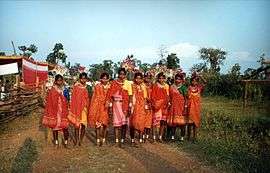Tribals in Madhya Pradesh

There are 46 recognized Scheduled Tribes in Madhya Pradesh, India, three of which have been identified as 'Particularly Vulnerable Tribal Groups' (PTGs)(formerly known as 'Special Primitive Tribal Groups'). The population of Scheduled Tribals (ST) is 21.1% of the state population (15.31 million out of 72.62 million), according to the 2011 census.[1] Bounded by the Narmada River to the north and the Godavari River to the southeast, tribal peoples occupy the slopes of the region's mountains.
The term "Scheduled Tribes" refers to specific indigenous peoples whose status is acknowledged to by the Constitution of India. The term Adivasi also applies to indigenous peoples of this area.
Diversity of tribes
The diversity in the tribes across the state comes from differences in heredity, lifestyle, cultural traditions, social structure, economic structure, religious beliefs and language and speech. Due to the different linguistic, cultural and geographical environments, the diverse tribal world of Madhya Pradesh has been largely cut off from the mainstream of development.
Madhya Pradesh holds 1st rank among all the States/Union Territories (UTs) in terms of Special Tribal population and 12th rank in respect of the proportion of ST population to total population.[2]
Distribution of tribal population
The main tribal groups in Madhya Pradesh are Gond, Bhil, Baiga, Korku, Bhariya, Halba, Kaul, Mariya, and Sahariya.
Dhar, Jhabua and Mandla districts have a more than 50 percent tribal population. In Khargone, Chhindwara, Seoni, Sidhi and Shahdol districts, 30 to 50 percent of the population is of tribes. The largest population is that of the Bhil tribe.
| Name of tribe | Sub-tribe | Population (Census 1981) | Districts inhabited |
|---|---|---|---|
| Gond | Pardhan, Agariya, Ojha, Nagarchi, Solhas | 5,349,883 | All districts, mainly spread on both banks of Narmada River in Vindhyas and Satpura, Balaghat. |
| Bhil | Barela, Bhilala, Patliya | 2,505,888 | Dhar, Jhabua, East Nimar |
| Baiga | Bijhwar, Narotia, Bharotiya, Nahar, Rai Bhaina, Kadh Bhaina | 248,949 | Mandla, Balaghat |
| Korku | Movasiruma, Nahala, Vavari, Bodoya | 66,781 | East Nimar, Hoshangabad, Betul, Chhindwara, Burhanpur |
| Bharia | Bhumiya, Bhuihar, Pando | 195,490 | Chhindwara, Jabalpur |
| Halba | Halbi, Bastariya | 236,375 | Balaghat |
| Kaul | Rohiya, patel, Rauthail | 123,811 | Rewa, Satna, Shahdol, Sidhi |
| Mariya | Abujh Mariya, Dandami Mariya, Metakoitur | 195,490 | Jabalpur, Mandla, Panna, Shahdol, Chhindwara |
| Saharia | – | 261,816 | Guna, Shivpuri, Morena, Gwalior, Vidisha, Rajgarh |
List of recognised tribes
Most populous tribes
According to the 2011 Census of India, Bhil is the most populous tribe with a total population of 4,618,068, constituting 37.7 per cent of the total ST population. Gond is the second largest tribe, with a population of 4,357,918 constituting 35.6 per cent. The next four populous tribes are: Kol, Korku, Sahariya and Baiga. These six tribes constitute 92.2 per cent of the total ST population of the State.
Pardhan, Saur and Bharia Bhumia have a population ranging from 105,692 to 2152,472; together, they form 3.2 percent of state population. Four tribes, namely, Majhi, Khairwar, Mawasi and Panika have populations in the range of 47,806 to 81,335, and account for another 2.2 percent of the ST population.
The remaining thirty three tribes (out of the total of 46 tribes) along with the generic tribes constitute the residual 2.5 per cent of total ST population. Tribes having below 1000 population are twelve in number.[2]
Bhils have the highest population in Jhabua district followed by Dhar, Barwani and Khargone districts.
Gonds have major concentrations in Dindori district, Chhindwara, Mandla, Betul, Seoni and Shahdol districts. Other four major groups Kol, Korku, Sahariya and Baiga have registered the highest population in Rewa, Khandwa, Shivpuri and Shahdol districts respectively.[2]
References
- ↑
- 1 2 3 "Madhya Pradesh: DATA HIGHLIGHTS: THE SCHEDULED TRIBES, Census of India 2001" (PDF). Govt. of Madhya Pradesh. Retrieved 2010-04-09.
External links
- Govt of MP schedule caste and schedule tribe welfare department
- Department of tribal development, MP government
- Census 2011 - Madhya Pradesh
Further reading
- Jain and Bhatnagar: Upkar Madhya Pradesh Samanya Gyan, Upkar Prakashan Agra
